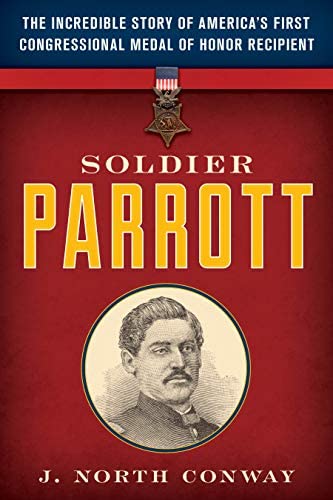By J. North Conway. The Rowman and Littlefield Publishing Group, 2021.
Reviewed by Lt. Col. Stephen A. Tribble, Ph.D., U.S. Army
The Congressional Medal of Honor (CMH), established in 1861, recognizes acts of valor by military members across the Joint Force and is coveted as the most prestigious United States (U.S.) military medal awarded. Soldier Parrott: The Incredible Story of America’s First Congressional Medal of Honor Recipient by Jack North Conway is an amazingly detailed account of the Andrews Raiders and Private Jacob Parrott’s valor during the operation. A group of twenty-four Union men, the Andrews Raiders penetrated two hundred miles behind enemy lines to sabotage the Confederate Western and Atlantic Railroad between Atlanta and Chattanooga. The author, Conway was an established poet, educator, writer, and musician from Taunton, MA, authoring seventeen books in his lifetime, this being one of his last. The first part of the secret mission required the raiders to move out from their Tennessee camp in small groups and rendezvous in Marietta, GA. From there, they would all pose as passengers and board a train north to Big Shanty, GA, the location of the raid. Part 1 of the book introduces Parrott and his traveling partner Private Samuel Robertson and details their three-day, 100-mile journey through Confederate territory. Parts Two, Three, and Four expand the scope of the book, adding details about other key figures and the raid.
The American Civil War ushered in numerous revolutions in military affairs, like hydrogen-filled balloons, “ironclad” submarines, and repeating rifles. Conway’s account of the Andrews Raid expertly highlights arguably two of the most important revolutions in military affairs during that time, railroads, and the telegraph. In 1862, Andrews Raiders stole a Confederate train (the General) from the station near Big Shanty, GA, with the intent of destroying and blocking rail lines to disrupt the Confederate movement of personnel and supplies. Under the pretense of a train commandeered to deliver ammunition to General
Beauregard fighting near Chattanooga, Andrews steamed the engine north toward Tennessee and the safety of the Union lines. The raiders cut telegraph lines along the way to protect their ruse and prevent advanced warning of their arrival at subsequent stations. Union leaders obviously understood the utility of covert sabotage and military deception. Conjuring the spirit of the great military artist Sun Tzu, the raid served as the Union’s attempt to take away the enemy’s ability to fight, defeating the Confederates without fighting. This covert action also demonstrates the Union’s understanding of the levels of war, employing tactical actions to yield operational and potentially strategic results.
However, the raid was an epic failure. The raid resulted in minimal impact on Confederate operations, and the Confederates quickly repaired all the damage inflicted on the railway and telegraph infrastructure. Even more, eight of the twenty-four raiders were captured, put on trial, and hanged for spying and treason. Other raiders spent upwards of two years in Confederate prisons. Nonetheless, the attempt was daring, and Parrott (and others) were deservingly rewarded. The raiders who escaped imprisonment were the first six American Soldiers to receive the CMH; Parrott just happened to be the first of the six to receive the award. Seven of the eight executed raiders received the CMH posthumously, and an additional nine received the CMH after the war.
The book clearly focuses on Parrott and his role in the raid. However, Conway dedicates significant sections of the book to the other prominent figures in the raid and provides detailed accounts of the lead-up to the raid, the raid itself, and the chase, as well as stories of capture, execution, imprisonment, and escape for several raiders. He also weaves in operational and strategic context to illustrate how broader wartime events related to, shaped, and impacted the raid.
Several books dating back to 1887 have been written about Andrews Raiders. There was even an American movie about the raid produced in 1956. While the event is well documented, this book seems to be the first accounting of one of the most important historical figures in American military history, the first American Soldier to receive the CMH. Using this perspective, Conway adds to the event’s literary record and provides a fresh look at the circumstances surrounding the raid. Most importantly, the book details the significant role Parrott played.
Overall, the book is an easy read with an organizational structure that walks the reader through an easy-to-follow timeline of events. Lovers of military history will enjoy Conway’s ability to weave together the story of the raid with a detailed account of Parrot’s heroic actions, the actions of his fellow raiders, and what happened after the raid. Educators will find this a helpful book for lessons on leadership, the revolution of military affairs, and the linkages between tactics, operations, and strategy.
Lt. Col. Trimble is an assistant professor at the Joint Forces Staff College.
Author J. North Conway has created a highly personal story of how Parrott felt and thought about his mission with information gleaned from contemporary newspaper article and commentary, journal entries and Congressional hearing reports. He lives in Assonet, MA.
Soldier Parrott: The Incredible Story of America’s First Congressional Medal of Honor Recipient. By J. North Conway (Guilford, CT: 2021)


